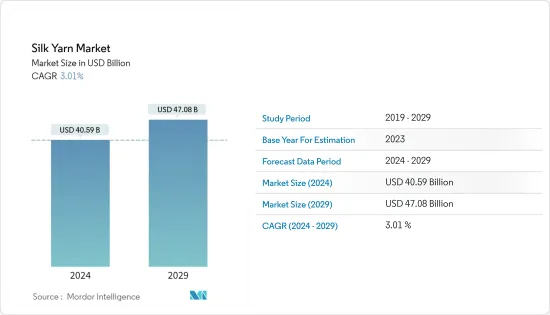 |
市场调查报告书
商品编码
1439771
丝线:市场占有率分析、产业趋势与统计、成长预测(2024-2029)Silk Yarn - Market Share Analysis, Industry Trends & Statistics, Growth Forecasts (2024 - 2029) |
||||||
※ 本网页内容可能与最新版本有所差异。详细情况请与我们联繫。
丝纱市场规模预计到2024年为405.9亿美元,预计到2029年将达到470.8亿美元,在预测期内(2024-2029年)复合年增长率为3.01%。

主要亮点
- 丝绸产业的工业化,加上各种政府计划,将增加亚太地区生丝的产量,进而增加丝纱的产量,使该地区成为预测期内最大的市场。
- 古巴等加勒比海国家和肯亚等非洲国家正在努力扩大丝绸生产。同样,卢安达政府已开始投资丝绸价值链的发展,该价值链将生产高品质的丝线,以满足亚洲不断增长的需求。 -高品质的丝绸产品提供了强劲的出口机会。为了开拓不断成长的全球市场,卢安达国家农业出口发展委员会 (NAEB) 也与韩国丝绸製造商 HEWorks 合作。
- 由于该产业是印度等国家外汇存底的主要来源,因此政府正在支持各种促进该产业发展的措施。印度有 52,360 个村庄从事养蚕业。该国使用原料製造丝绸服装类、化妆品、纺织品、纱线、地毯、披肩、围巾、枕头套和配件。
- 印度、中国、美国、美国、法国、瑞士、日本、越南、阿联酋、英国、德国、韩国等国家是丝绸及丝绸製品的主要消费国。丝绸产业的工业化,加上各种政府计划,将增加亚太地区生丝的产量,进而增加丝纱的产量,使该地区成为预测期内最大的市场。
丝绸市场趋势
义大利正在成为欧洲领先的丝绸生产国
义大利是欧洲地区丝绸的主要生产国之一,近年来已有数百个农场开始养蚕。近年来,使用义大利种植的蚕生产的丝绸产量不断增加。 ONGETTA SRL 等公司专注于丝绸慢蛰,并以 ONGETTA BIO SILK 品牌生产经过 GOTS 认证的有机丝绸。这是欧洲第一家获得 GOTS 认证的丝纺加捻工厂。
随着中国丝绸出口的下降,义大利丝绸生产商可能有更多机会进入全球市场。而且,中国丝绸的价格上涨,远超过义大利产自义大利蚕丝的价格。如果这样的话,国产丝线将会进一步成长。
然而,义大利的丝绸产量和出口量与中国的丝绸产量和出口量相比微不足道。 2021年,义大利向全球出口了价值1,821.4万美元的丝纱。与2020年相比成长8%,主要出口目的地为法国、罗马尼亚、英国、奥地利和德国。
亚太地区主导市场
中国是世界上最大的丝绸产品生产国和出口国,包括丝绸和丝线。然而,由于桑树种植成本不断上涨,许多农民被迫退出养蚕业。丝绸主要产于长江Delta南部地区。着名的丝绸产区有江苏、浙江、四川等地。苏州、杭州、南京、绍兴等城市以丝绸产业闻名。
乌兹别克也是着名的丝绸生产国。这个国家的丝绸产品在世界市场上受到高度重视。该国最近成立了一个名为「乌兹别克Pasoat」的组织。该组织致力于改善蚕茧生产以及丝绸纺织品的加工和製造。与本地和国际製造商的合作正在进行中,并鼓励和支持自营业丝绸生产商。乌兹别克是继中国和印度之后的世界第三大丝绸生产国。
印度正在透过中央丝绸局(CSB)实施一项名为「Silk Samagra」的计划,以提高国内丝绸的品质和生产率,从而减少生丝进口。为了促进奥里萨邦的 Tussar 丝绸种植,卡迪村工业委员会 (KVIC) 最近在该地区的乔德瓦尔建立了该州第一个丝绸生产中心。丝绸产业的工业化加上各种政府计画将导致亚太地区生丝产量增加,从而带动丝纱产量增加,使该地区成为预测期间最大的市场时期。
丝绸产业概况
其他福利
- Excel 格式的市场预测 (ME) 表
- 3 个月分析师支持
目录
第一章简介
- 研究假设和市场定义
- 调查范围
第二章调查方法
第三章执行摘要
第四章市场动态
- 市场概况
- 市场驱动因素
- 市场限制因素
- 价值链分析
第五章市场区隔
- 地区(产量分析、消费金额及数量分析、进口金额及数量分析、出口金额及数量分析、价格趋势分析)
- 美国
- 中国
- 印度
- 泰国
- 德国
- 义大利
- 英国
- 巴西
- 突尼西亚
第六章市场机会与未来趋势
The Silk Yarn Market size is estimated at USD 40.59 billion in 2024, and is expected to reach USD 47.08 billion by 2029, growing at a CAGR of 3.01% during the forecast period (2024-2029).

Key Highlights
- The industrialization of the silk industry coupled with various government schemes will boost the production of raw silk in the Asia-pacific region which in turn increase the production of silk yarn making the region to be the largest market during the forecast period.
- Caribbean countries such as Cuba and African Countries including Kenya are making an effort to boost their silk yarn production.The Government of Rwanda as well as has begun investing in the development of silk value chains, with the rising demand from Asia, the production of high-quality silk products offers strong export opportunities. To tap into growing global markets, Rwanda's National Agricultural Export Development Board (NAEB) has also partnered with HEWorks, a Korean silk manufacturer.
- The sector is a major provider to foreign exchange reserves in nations such as India which is why the government supports with various initiatives to boost the industry. In India, sericulture operations are distributed throughout 52,360 villages. The country uses raw materials to manufacture silk garments, made-ups, textiles, yarns, carpets, shawls, scarves, pillow coverings, and accessories.
- Countries such as India, China, the United States of America, Italy, France, Switzerland, Japan, Vietnam, the United Arab Emirates, the United Kingdom, Germany, and Korea are some of the major consumers of silk and silk products. The industrialization of the silk industry coupled with various government schemes will boost the production of raw silk in the Asia-pacific region which in turn increases the production of silk yarn, making the region to be the largest market during the forecast period.
Silk Yarn Market Trends
Italy is Emerging as Major Producer of Silk Yarn in Europe
Italy is one of the major producers of silk yarn in the European region, as hundreds of farms have started rearing silkworms in the past few years. Silk production using silk worms grown in Italy has been on the rise in recent years. Comapnies such as ONGETTA SRL is specialized in the silk throwsting and produces GOTS certified organic silk that is branded ONGETTA BIO SILK. It was the first spinning and twisting mill of GOTS certified silk yarns in Europe.
The decrease in exports of silk yarn from China is likely to give more access to the Italian silk yarn producers to the global market. Further, the price of Chinese silk has been climbing, far surpassing the price of silk threads produced in Italy from Italian-grown silkworms. This would further boost domestically produced silk yarn.
However, the production and export of silk yarn from Italy are minuscule when compared to Chinese production and export of silk yarn. In 2021, Italy exported silk yarn which valued at USD 18,214 thousand worldwide, which have increased by 8% as compared to 2020 and the major destinations were France, Romania, United Kingdom, Austria, and Germany.
Asia Pacific Dominates the Market
China is worlds largest producer and export silk and silk products including silk yarns. However, the rising costs of mulberry cultivation are forcing many farmers to exit sericulture.Silk is mainly produced in the south of the Yangtze River Delta. Renowned silk producing regions are Jiangsu, Zhejiang and Sichuan provinces. Cities such as Suzhou, Hangzhou, Nanjing, and Shaoxing are well known for their silk industries.
Uzbekistan is another prominent producer of silk. The silk products of the country are highly valued in the global market. In the nation, the organisation "UZBEKIPAKSANOAT" was founded recently. The organisation is working hard to improve silkworm cocoon production, as well as silk fabric processing and manufacturing. Collaboration with local and worldwide manufacturers is underway, and self-employed silk producers are encouraged and supported. After China and India, Uzbekistan is the world's third largest producer of silk.
India has implemented a scheme called Silk Samagra through its Central Silk Board (CSB) to enhance the quality and productivity of domestic silk to reduce the country's import of raw silk. In order to promote tussar silk cultivation in Odisha, the Khadi and Village Industries Commission (KVIC) in has recently established the State's first silk yarn production centre at Choudwar in the district .The industrialisation of the silk industry coupled with various government schemes will boost the production of raw silk in the Asia-pacific region which in turn increase the production of silk yarn making the region to be the largest market during the forecast period.
Silk Yarn Industry Overview
Additional Benefits:
- The market estimate (ME) sheet in Excel format
- 3 months of analyst support
TABLE OF CONTENTS
1 INTRODUCTION
- 1.1 Study Assumptions & Market Definition
- 1.2 Scope of the Study
2 RESEARCH METHODOLOGY
3 EXECUTIVE SUMMARY
4 MARKET DYNAMICS
- 4.1 Market Overview
- 4.2 Market Drivers
- 4.3 Market Restraints
- 4.4 Value Chain Analysis
5 MARKET SEGMENTATION
- 5.1 Geography (Production Analysis, Consumption Analysis by Value & Volume, Import Analysis by Value & Volume, Export Analysis by Value & Volume and Price Trend Analysis)
- 5.1.1 United States
- 5.1.2 China
- 5.1.3 India
- 5.1.4 Thailand
- 5.1.5 Germany
- 5.1.6 Italy
- 5.1.7 United Kingdom
- 5.1.8 Brazil
- 5.1.9 Tunisia









